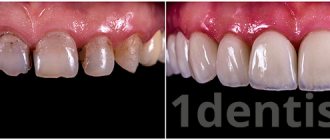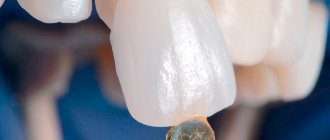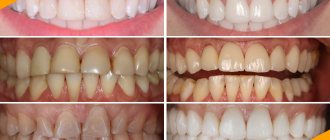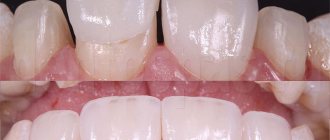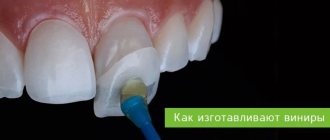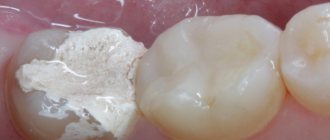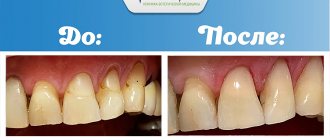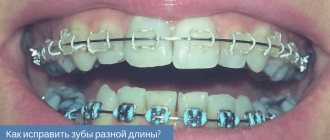Veneers are microprostheses that are widely used in aesthetic dentistry and allow you to achieve the ideal appearance of the anterior group of teeth. They are used in cases where existing defects cannot be corrected by other methods or the result is needed in a short time. Unlike crowns, they do not completely cover the teeth, but only their front part and the cutting edge. Most often, veneers are installed on the 8 lower and 10 upper teeth. Is it necessary to install veneers, their pros and cons - this is discussed in our article.
What are veneers for?
In what cases are veneers placed on teeth? Installation of veneers is recommended for:
- darkening of the enamel that does not disappear after the whitening procedure;
- cracks and chips;
- non-carious enamel damage (fluorosis, tetracycline staining);
- irregularities in shape (uneven teeth) and position of teeth.
Restorations with veneers can be direct or indirect. The first ones are carried out directly in the patient’s mouth, and indirect ones - in a laboratory setting. Indirect ones allow you to achieve higher aesthetic results; teeth after such restorations look more natural, and veneers made of zirconium, ceramics or composite materials are used for their implementation.
How veneers differ from crowns and composite restorations
Veneers, crowns and composite restorations solve various dental problems:
- Veneers are designed to improve the appearance of teeth. With their help, you can get straight teeth in a few days, sometimes in one visit to an orthopedic dentist, and hide visual defects - unsightly color, darkened fillings, crookedness.
- The purpose of a crown is to protect the tooth from destruction. Typically, crowns are placed on teeth after root canal treatment and nerve removal. After opening the cavity due to pulpitis, periodontitis or caries, the tooth becomes more vulnerable and is destroyed faster. To preserve it, the surface is completely covered with a crown.
- Composite restoration is the restoration of the shape of a partially destroyed tooth using filling materials. For example, when part of the crown broke off or the doctor had to remove enamel and dentin in a significant area due to severe caries damage.
Let’s summarize the differences: with the help of veneers, visual defects are eliminated, crowns are necessary to protect teeth from destruction, and composite restoration is used to restore damaged teeth.
Does it hurt to put veneers on teeth?
Veneers are micro-prosthetic onlays, during the installation of which nerves are not removed and soft tissues are not damaged. Before installing them, a layer no more than 1.2 mm thick is removed from the tooth, and the procedure itself is preceded by anesthesia, which guarantees a complete absence of unpleasant sensations. The time required to prepare the tooth is about half an hour.
The pads do not cause discomfort when worn. After just a few days, the patient perceives the veneers as part of the teeth. The changes will only be aesthetic and for the better.
What are Lumineers?
Lumineers are a separate type of dental coverings. They differ from veneers in thickness, which does not exceed 0.2 mm, and in the installation method. Due to the thinness of the plates, in most cases they are installed without grinding the tooth enamel. Lumineers are installed if there is no need to visually correct the shape of the tooth. The main disadvantages of lumineers are:
- Low strength. It is physically impossible to provide it with a minimum thickness of 0.2 mm;
- High price. Lumineers are the most expensive type of veneers.
Dental veneers: pros and cons
Installation of veneers is one of the most popular methods of aesthetic dentistry, preferred by many patients. We will look at the main pros and cons of dental veneers, which will help you assess the risks and draw the right conclusions.
Advantages of veneers:
- Long service life. Varies depending on the quality of materials and technologies used and can reach 10 years.
- Resistance to staining. This is typical for ceramic veneers, which are highly resistant to all coloring substances without exception. The appearance of ceramic veneers remains unchanged throughout their entire service life.
- Natural look. Microprostheses are selected in accordance with the color of the enamel of natural teeth, so they look as natural as possible.
- Quick installation. Veneers will take a maximum of one week to complete, although they usually take much less time.
- Simple procedure. Unlike crowns, much less tooth tissue is removed, so the procedure takes less time and requires less effort.
Disadvantages of veneers:
- Strength. Veneers are considered to be quite wear-resistant structures; however, when using them, you should avoid eating too hard food and be careful when practicing martial arts (boxing, wrestling, etc.).
- Need for replacement. At the end of their service life (usually about 10 years), veneers must be replaced.
- Difficult to select for teeth with dark shades. Ceramic veneers are transparent, so they cannot correct teeth that are too dark.
- Tooth preparation. To install veneers, a layer of dental tissue is removed - this is a painless procedure, which is more gentle than when installing crowns, but, nevertheless, this is what worries patients most often.
- Price. Microprostheses are quite expensive products, the price of which is higher than that of crowns. Why are veneers so expensive? The determining factors in this case are the technologies and materials used. The most expensive are ceramic veneers (Lumineers).
Installation Cons
Despite all the advantages, this restoration method also has some disadvantages.
- The main disadvantage is that installation requires preliminary grinding of the teeth . Accordingly, they will never have the same shape and will have to be worn constantly.
- Among the disadvantages, we can highlight some features of the materials from which they are made. For example, porcelain onlays are too fragile, and composite ones can change color.
Get professional advice on installing high-quality and attractive veneers from us. Elena Plus dentists will do everything to ensure that the veneers serve you for as long as possible.
Types of veneers
For the manufacture of veneers, two types of materials are used, based on which the following types of products are distinguished:
- Ceramic. In turn, they are divided into porcelain and zirconium. The latter uses zirconium to make the frame, but the veneers themselves are also made of porcelain. They are more reliable than conventional pressed ones, but have less transparency due to the dense frame. The material for making veneers should be selected based on the color of the enamel of natural teeth. For transparent enamel, porcelain microprostheses are more suitable.
- Composite. Veneers, the manufacture of which can even be done by a general practitioner, since the entire process is carried out directly in the patient’s mouth. Therefore, they are often compared to conventional fillings. To produce high-quality composite veneers, you will need a well-equipped laboratory.
How long does it take to replace veneers?
The service life of veneers depends on many factors:
- Material. Ceramic ones are more durable;
- The patient’s lifestyle, how carefully he “handles” dental veneers;
- Doctor's professionalism. If mistakes were made during installation, for example, the materials were not dried correctly, the veneers will not last long.
There is no clear period after which the linings must be replaced. This should only be done if there is an objective need. For example, if the veneer:
- Broken off;
- Peeled off;
- Darkened (relevant for composite overlays).
Contraindications for installing veneers
The following contraindications exist for installing veneers:
- high tooth wear (especially in older people);
- bruxism (the habit of grinding teeth during night sleep);
- thin tooth enamel;
- presence of carious lesions;
- large chipped teeth;
- presence of large fillings;
- soft tissue lesions (gingivitis, periodontal disease, etc.);
- loss of the sixth and seventh chewing teeth.
Should I get veneers? Is there any reason to worry that their installation will harm you? The danger of veneers, which is rumored in certain circles of patients, is nothing more than a myth. We are talking about possible damage to healthy teeth when preparing them for the installation of veneers. But thanks to the advent of new ultra-thin veneers, today it is only necessary to prepare the enamel by 0.3-0.5 mm, and the tooth remains alive (crowns are installed on “dead” teeth).
How is turning for veneers carried out?
The reliability of the installation of microprostheses depends on the quality of preparation of the dental surface. Traditionally, the stage of grinding teeth before veneers proceeds as follows. First, the doctor determines the thickness of the enamel layer on the vestibular surface of the teeth that will need to be removed. Next, the dentist makes grooves with a special tool and, focusing on them, grinds down the required amount of dental tissue. In this case, near the gum, the preparation is performed in the form of a grooved ledge. Then the doctor moves on to treating the side surfaces. It can be carried out in two ways: by maintaining the contact points between the teeth or by slightly “grabbing” their lingual surface. The first option is good for preserving the integrity of the dentition, the second has a positive effect on the appearance of future veneers. As for the incisal edge of the teeth, the need for grinding it is directly related to the model of the veneer and the technical requirements for its installation.
Make an appointment
right now!
Mikhailov Andrey Vladimirovich
Surgeon, Orthopedist, Implantologist
Is it worth getting veneers?
The answer of a doctor who is faced with the question of whether it is worth putting veneers on teeth is always obvious. Increased sensitivity of teeth, significant damage to the enamel, a large number of fillings on the front teeth - all this is a good reason to carry out restoration using ceramic veneers. If we are talking only about aesthetics, then the final decision must be made by the patient himself. In our opinion, this method of restoration has enough advantages and we tried to describe them as fully as possible. The only and most significant disadvantage can be considered the irreversibility of the procedure, but beauty, as we know, requires sacrifice.
Making veneers and installing them is a jewelry and creative work. Do not forget that the thickness of the microprosthesis does not exceed 0.6 mm (for lumineers - up to 0.1 mm), so your ideal smile will be guaranteed not only by advanced technologies and high-quality materials, but also by the professionalism of orthopedists and therapists. You can count on all this at Amel Dental - the only dental clinic in our country that is accredited by the Global Clinic Rating and is among the 200 best clinics in the world providing dental services.
How are veneers different from braces?
Both veneers and braces are used to eliminate defects and make your smile beautiful. But they solve this problem in different ways:
- Veneers are permanent coverings that are attached to the surface of the tooth and remain there forever (unless there is a need to replace them). They create the necessary visual effect.
- Braces are a removable orthodontic structure whose task is to physiologically change the position of teeth in the dentition and correct the bite. Once the goal is achieved, the braces are removed.
Not in all cases, veneers are enough to eliminate the defect. For example, if a patient’s teeth are severely crooked or have an incorrect bite, it is not recommended to install veneers. In order to create the effect of an even row with their help, the teeth will have to be sharpened greatly, and this will significantly speed up their destruction. In case of such defects, it is advisable to straighten the teeth using braces.


